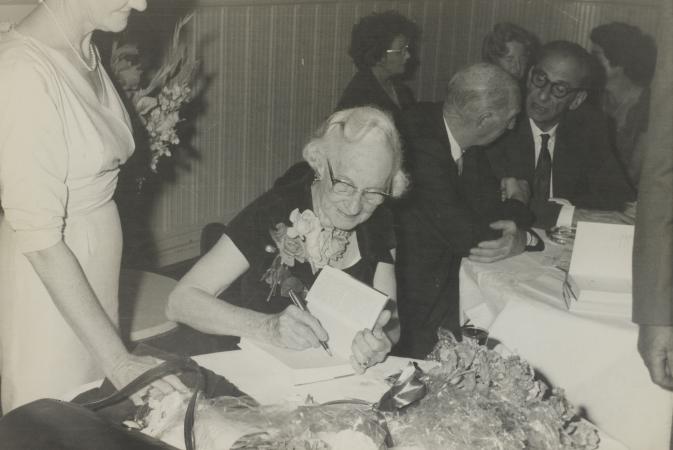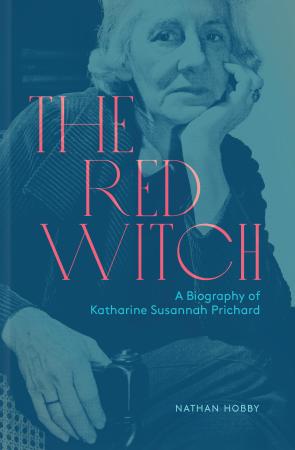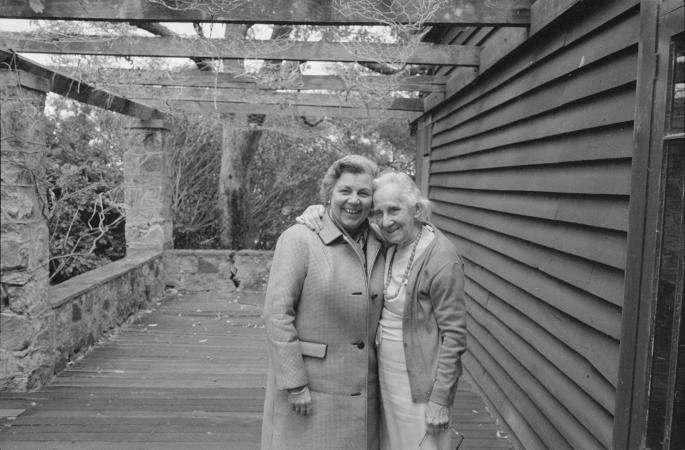Dr Kate explores the archives and writing of Katharine Susannah Prichard (1883-1969) with her biographer Dr Nathan Hobby, who has just published The Red Witch: A Biography of Katharine Susannah Prichard (MUP, 2022).
Katharine Susannah Prichard is one of Australia’s most beloved authors, who depicted a new vision of Australia within her writing. She wrote 13 novels, 4 collections of short stories as well as plays and poetry. Her lifelong commitment to communism and the Soviet Union contrasts with her marriage to a well decorated First World War veteran Hugo Throssell who was awarded the Victoria Cross.
View the State Library catalogue to find materials of some of Prichard's letters, scrapbooks, articles and speeches.
Thanks to the Untapped Australian Literary Heritage Project, many of KSP’s out of print books are now accessible to contemporary readers.
Transcript
BEGINNING OF INTERVIEW
Justin: And joining us today we are talking about the subject, a very fascinating one: Katharine Susannah Prichard might be known to some of you but for those of you who have never heard of her, get yourself a cuppa, sit back and you are going to enjoy this one.
Joining us today, is Dr Kate Gregory who is a Battye Historian at The State Library and also today Dr Nathan Hobby, author of The Red Witch a biography of Katharine Susannah Prichard just published by Melbourne University and let’s chat first off with Dr Hobby before we get too deep on this. In a nutshell who was Katharine?
Dr NH: Thank you Justin. So Katharine Susannah Prichard was a great novelist who really put Australian literature on the map in the early twentieth century. She wrote about Australian places in new ways and Australian ways of life and Australian work and she lived in Perth from the time she married the war hero Hugo Throssell until her death in 1969 in a cottage in Greenmount which still stands today. It’s the home of the KSP Writers’ Centre and she is as well as being appreciated so deeply for her contribution to literature, she also is famous as a communist and her journey into communism and then her time as a communist for the last 50 years of her life form an important part of her story and make her a really interesting historical figure.
Justin: And I don’t think you get a name like The Red Witch very easily. Why was this her name that she was also called?
Dr NH: It’s an ambiguous name actually. So, I chose it because it means different things. When she turned 80, her friend Joan Williams, the journalist wrote a profile in which she says that some people and who she actually meant was her grandmother pointed out the cottage on the hill and said, “A red witch lives there.” Her grandmother actually meant it in a positive way, being sort of into witchcraft or those sorts of things but it was taken a bit differently to also mean the way as a communist during the cold war, Katharine was very much on the outer, so just the meaning of the name will sort of vary according to who you are and it took off a bit particularly after she died. It sort of became a legendary name for Katharine.
Justin: And so why was her writing and what she did so prolific?
Dr NH: So she put different places that had never been explored in literature before on the map and she did that for the … in Western Australia, she did that for the Pemberton area, Pemberton and Manjimup Greenbushes in her novel Working Bullocks published in 1926, the story of timber workers who did it for the Pilbara; in Coonardoo which is probably her most famous novel set on a cattle station and that was published in 1929 and she also wrote about the beaches of Perth in Intimate Strangers and about the Goldfields in her great saga of the West Australian Goldfields which got published between 1946 and 1950 starting with The Roaring Nineties. So in each of these, she would go a particular part of Australia and spend a couple of months there taking notes, observing deeply and then write a story of the people and their way of life; all of them really interesting novels.
Justin: And how was her… the work that she has done, you know, you said she documented so much of the landscapes of Western Australia very early on like not many other authors had. How were they received to this day?
Dr NH: So she probably stood up better than a lot of her contemporaries. She’s still read today, she’s still studied at universities and researchers. Obviously, Australian literature always struggles a bit to find its readers and its been really great that a couple of her books have just come back into availability as e-books through the Untapped: Literary Heritage Project that’s brought back Working Bullocks and Intimate Strangers. A lot of the others you can still find in print. She still has a really loyal readership and I’m just constantly coming across people for whom her books have meant so much over the years.
Justin: And were they pretty ground breaking in the day when they were first released?
Dr NH: Yes, absolutely. So she won many awards for her novels and it was just very invigorating and fresh to have these stories of Australian people and their ways of life and the sort of work they did. She wrote about groups of people in a really interesting way. She sort of talks about the way people are embodied in their communities and the way communities interact and that makes her a really interesting writer and she has very vivid characters who come alive off the page and really hold up in many ways all these years later.
Justin: And I’m sure you were doing a lot of research in … before writing this book. Was there anything that you stumbled across that was out of the blue or something that was really exciting that you kind of found along the journey?
Dr NH: Yes, there were so many moments. I just love the process of archival research as being in amongst the letters and papers that were once held by Katharine and her contemporary. But one story that stands out to me is using the State Library of Western Australia’s collections, I ordered to be retrieved the scrapbook kept by Katharine’s husband Hugo Throssell and it wasn’t meant to have anything relevant, it was just some newspaper clippings but then I found inside it a receipt from their wedding day showing that he’d … the ring … the wedding ring that he’d brought on the very morning they were getting married which showed what a hurry their wedding was at the end of the war. In one sense it gave some insight into his character and then next to it also was a receipt from their honeymoon and it was perhaps the first time her name had been written as Mrs Throssell and it was from the Emerald General Store and it showed what they ate on their honeymoon including Beefine or something like that or liquid beef and some various other things. They’re the sort of details that I think can bring the past to life and so that detail found its way into my book and I was very grateful for The State Library of Western Australia preserving that for future researchers like me.
Justin: So like most men he was also a bit of a procrastinator by the sounds of it?
Dr NH: Yes, quite possibly [laughs]. Look, he had a good reason. He’d just got back from the war. He was a Victoria Cross winner and they got married in a real hurry so he had business to attend to back in Western Australia and he caught the train back just in time to marry Katharine in the middle of … I think it was the very day that Melbourne was quarantined due to the Spanish flu outbreak so they were getting married on a dramatic day.
Justin: I want to bring into the conversation now Dr Kate Gregory who is the Battye Historian at the State Library of WA and joins us many a time on History Repeated.
Dr Kate, can you tell me a little bit about the archives that you have? I’ve heard that they should be a little bit bigger.
Dr KG: Yes, that’s right Justin and I think … I mean this is one of the fascinating aspects to Katharine’s story.
So she … in the last years of her life, she was very actively burning her private papers [laughs]. Actually destroying … yes, she didn’t want … she wanted I guess a certain amount of control over what was left after she died and so that means unfortunately that there would be large passages of her life and periods potentially just represented in a very limited way or… I don’t know. It’s an interesting one. I was having this conversation with Nathan actually earlier today who assures me that there is still a really rich record relating to Katharine Susannah Prichard and in fact when I started looking into the State Library collections, he is absolutely right. It really is about as he sort of touched on, the contemporaries of Katharine and that kind of social environment in which Katharine was living and working and that is what is reflected throughout our collection. So although we do have materials that are photocopied from the Moscow archives; so they’re letters. There are lots and lots of letters from Katharine Susannah Prichard and she was writing to the Soviet Union; her comrades and colleagues in the Soviet Union and we’ve got a copy of those letters in our collections and they are fascinating, absolutely fascinating. It just shows how committed to communism she was and to that cause. But so the majority of her private papers are with the National Library and … but then things like the John and Roma Gilchrist papers. There’s a lot of material. They were very good friends of Katharine’s and there’s a lot of photographs. There’s a wonderful portrait, a sketch of Katharine Susannah in our collection as well by Enid Dickson I think it is. So there’s a rich range of material throughout the State Library collection because she was such an important figure I suppose and influenced so many people and was so fascinating in her own right so there is a lot on her even though she destroyed a lot of her own private papers.
Justin: And how is the destroying of the papers documented? Where do you find that information?
Dr KG: Well, that’s in Rick Throssell … her son Rick Throssell. So he did write a biography of ‘KSP’ as she referred to herself and I think that’s a bit of a nice way to … she’s still referred to as KSP rather than … the writers … WA Writers’ Group up at Greenmount which is her old … her former home. So her son does document that in his opening pages of his biography of his mother and it’s referred to in letters so there were … some of her friends and contemporaries who she was corresponding with were urging her to reconsider this business of destroying all of her private papers, so yes. But she didn’t … I don’t think she heeded that advice. She did go ahead with what she was doing and it’s quite a dramatic act I think.
Justin: This is Dr Kate Gregory. She is a Battye Historian with the State Library and she is joining us for History Repeated, alongside Dr Nathan Hobby, author of The Red Witch; the story of Katharine Susannah Prichard.
Dr Hobby, she was pretty radical with her politics. Can you tell me a little about her beliefs and what she stood for?
Dr NH: Sure, Katharine Susannah Prichard started out … her father was actually quite a conservative person politically and wrote columns for the newspapers that were on the quite right side of politics urging against minimum wage and things like this but in her early adulthood, she fell under the influence of more progressive people including Alfred Deakin the Prime Minister at the time and she started to move a little bit more towards the left and it was actually World War I which really shifted her. She was horrified by what she ended up seeing in World War I. The death of her brother Allan; her beloved brother, the growing sense that something had gone very wrong with the world and something needed to change to make the world a more just place and she thought that was about class and about the workers being given control of the economy and so she was really inspired by the Bolshevik revolution in Russia in 1917 and when the communist party of Australia was founded in 1920, she was told to start a branch in Perth and she did so.
Justin: That’s Dr Hobby; Nathan Hobby you’re hearing there.
Dr Gregory, when we are talking about piecing together her story, where it started, what you have left; what have you gathered as a bit of over-arching of who she was and what she did?
Dr KG: Well, I think probably Nathan as the biographer might be best placed to ask this … answer this question, but I think for me, she … her contribution I suppose to writing a kind of new vision of what Australia was and is and this is kind of I suppose … it’s the era when Australia is starting to forge it’s own identity separate from or out of the British empire and for me her kind of approach to writing about the Australian landscape, characters, language, through close observation and really a kind of sense of realism is so valuable today. So her creative vision I suppose and impression of those situations really in the past really helps us today and in a way we can sort of marry that creative picture that she paints with the archival evidence, you know with the archival evidence of those historical circumstances that she’s writing about, for example the timber logging around Pemberton in the 1920s and many other and the Pilbara stations that she writes about so I think it is incredibly valuable because in a way it sort of can … we’ve got the historical records and archives and all sorts of fragments of evidence that we can sort of piece together but as well as that, this kind of creative vision of what that past was like so I actually think it’s really quite exciting from a contemporary reader’s perspective.
Justin: And Nathan, before I let you go, what impact on present day would you say that Katharine Susannah Prichard had on modern writing and beliefs?
Dr NH: One key influence is I guess inspiring future generations of writers to continue writing about the landscape in new ways. I mean she wasn’t the first to do that, but she was certainly a strong early voice in writing in new ways about the landscape and I think that she gave people permission to be proud of our country and its people and its places and to see them as a source for inspiration and to write about them in new ways and it’s a challenge that’s been taken up by all the generations since her.
Justin: Well thank you Kate and Nathan for indulging us in the world of Katharine Susannah Prichard. I appreciate both your times.
Dr NH: Thanks Justin.
Dr KG: Thanks Justin, can I also just mention for people who are interested, we are actually having an event next week; next Wednesday 25th May. Nathan and I will be in conversation at the State Library in the State Library theatre so for anyone who is interested, please do have a look on the State Library website and you can register for that event.
Justin: Thank you for that Kate.
If you want to get on down there, you can give us a call and we can get that information for you if you missed it or you can jump on the State Library website as Dr Kate Gregory, Battye Historian from t he State Library had let you know and thank you again to Dr Nathan Hobby, Author of The Red Witch. We were looking at the life of Katharine Susannah Prichard.
Thank you for joining us.
END OF INTERVIEW



